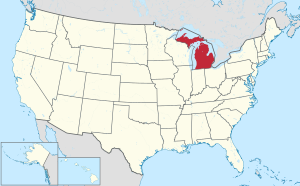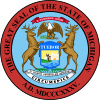
Back Michigan Afrikaans ሚሺጋን Amharic Michigan AN Miscegan ANG ميشيغان Arabic ܡܫܝܓܢ ARC ميشيݣن ARY ميشيجان ARZ Michigan AST Michigan suyu Aymara
Michigan | |
|---|---|
| Nicknames: "The Great Lakes State", "The Wolverine State", "Water (Winter) Wonderland" | |
| Motto(s): Si quaeris peninsulam amoenam circumspice (English: "If you seek a pleasant peninsula, look about you") | |
| Anthem: "My Michigan" | |
 Location of Michigan within the United States | |
| Country | United States |
| Before statehood | Michigan Territory |
| Admitted to the Union | January 26, 1837 (26th) |
| Capital | Lansing |
| Largest city | Detroit |
| Largest county or equivalent | Wayne |
| Largest metro and urban areas | Detroit |
| Government | |
| • Governor | Gretchen Whitmer (D) |
| • Lieutenant Governor | Garlin Gilchrist (D) |
| Legislature | Michigan Legislature |
| • Upper house | Senate |
| • Lower house | House of Representatives |
| Judiciary | Michigan Supreme Court |
| U.S. senators | Gary Peters (D) Elissa Slotkin (D) |
| U.S. House delegation | 7 Republicans 6 Democrats (list) |
| Area | |
• Total | 96,716 sq mi (250,493 km2) |
| • Land | 58,110 sq mi (150,504 km2) |
| • Water | 38,606 sq mi (99,990 km2) 41.8% |
| • Rank | 11th |
| Dimensions | |
| • Length | 456[1] mi (734 km) |
| • Width | 386[1] mi (621 km) |
| Elevation | 900 ft (270 m) |
| Highest elevation | 1,979 ft (603 m) |
| Lowest elevation | 571 ft (174 m) |
| Population (2024) | |
• Total | |
| • Rank | 10th |
| • Density | 174/sq mi (67.1/km2) |
| • Rank | 17th |
| • Median household income | $71,100 (2023)[4] |
| • Income rank | 32nd |
| Demonym(s) | Michigander, Michiganian, Yooper (Upper Peninsula)[5] |
| Language | |
| • Official language | None (English, de facto) |
| • Spoken language | English 91.11% Spanish 3.86% Arabic 1.05% Other 4.92% |
| Time zones | |
| Most of state | UTC−05:00 (Eastern) |
| • Summer (DST) | UTC−04:00 (EDT) |
| 4 U.P. counties (Gogebic, Iron, Dickinson, and Menominee) | UTC−06:00 (Central) |
| • Summer (DST) | UTC−05:00 (CDT) |
| USPS abbreviation | MI |
| ISO 3166 code | US-MI |
| Traditional abbreviation | Mich. |
| Latitude | 41°41′ N to 48°18′ N |
| Longitude | 82°7′ W to 90°25′ W |
| Website | michigan |
| List of state symbols | |
|---|---|
| Living insignia | |
| Bird | American robin (Turdus migratorius) |
| Fish | Brook trout (Salvelinus fontinalis) |
| Flower | Apple blossom (Malus domestica) Wildflower: Dwarf lake iris (Iris lacustris) |
| Mammal | Unofficial: Wolverine (Gulo gulo luscus) Game animal: White-tailed deer (Odocoileus virginianus) |
| Reptile | Painted turtle (Chrysemys picta) |
| Tree | Eastern white pine (Pinus strobus) |
| Inanimate insignia | |
| Food | Manoomin (state native grain)[6][7] |
| Fossil | Mastodon (Mammut americanum) |
| Gemstone | Isle Royale greenstone |
| Rock | Petoskey stone |
| Soil | Kalkaska sand |
| State route marker | |
 | |
| State quarter | |
 Released in 2004 | |
| Lists of United States state symbols | |
Michigan (/ˈmɪʃɪɡən/ ⓘ MISH-ig-ən) is a state in the Great Lakes region of the Upper Midwestern United States. It shares water and land boundaries with Minnesota to the northwest, Wisconsin to the west, Indiana and Illinois to the southwest, Ohio to the southeast, and the Canadian province of Ontario to the east, northeast and north. With a population of 10.14 million[8] and an area of 96,716 sq mi (250,490 km2), Michigan is the 10th-largest state by population, the 11th-largest by area, and the largest by total area east of the Mississippi River.[b] The state capital is Lansing, while its most populous city is Detroit. The Metro Detroit region in Southeast Michigan is among the nation's most populous and largest metropolitan economies. Other important metropolitan areas include Grand Rapids, Flint, Ann Arbor, Kalamazoo, the Tri-Cities, and Muskegon.
Michigan consists of two peninsulas: the heavily forested Upper Peninsula (commonly called "the U.P."), which juts eastward from northern Wisconsin, and the more populated Lower Peninsula, stretching north from Ohio and Indiana. The peninsulas are separated by the Straits of Mackinac, which connects Lake Michigan and Lake Huron, and are linked by the 5-mile-long Mackinac Bridge along Interstate 75. Bordering four of the five Great Lakes and Lake St. Clair, Michigan has the longest freshwater coastline of any U.S. political subdivision, measuring 3,288 miles.[9] The state ranks second behind Alaska in water coverage by square miles and first in percentage, with approximately 42%, and it also contains 64,980 inland lakes and ponds. [10][11]
In the 17th century, French explorers claimed the Great Lakes region for New France, though the area had largely been inhabited for thousands of years by Indigenous peoples such as the Ojibwe, Odawa, Potawatomi, and Wyandot. French settlers and Métis established forts and settlements, with the region’s name derived from the Ojibwe word ᒥᓯᑲᒥ (mishigami),[c] meaning "large water" or "large lake".[1][12] After France's defeat in the French and Indian War in 1762, the area came under British control and later the U.S. following the Treaty of Paris (1783), though control remained disputed with Indigenous tribes until treaties between 1795 and 1842. The area was part of the larger Northwest Territory; the Michigan Territory was organized in 1805. Michigan was admitted as the 26th state on January 26, 1837, entering as a free state and quickly developing into an industrial and trade hub that attracted European immigrants, particularly from Finland, Macedonia, and the Netherlands.[13] In the 1930s, migration from Appalachia and the Great Migration of Black Southerners further shaped the state, especially in Metro Detroit.[14][15]
Michigan has a diversified economy with a gross state product of $711.481 billion as of Q3 2024, ranking 14th among the 50 states.[16] Although the state has developed a diverse economy, in the early 20th century it became widely known as the center of the U.S. automotive industry, which developed as a major national economic force. It is home to the country's three major automobile companies (whose headquarters are all in Metro Detroit). Once exploited for logging and mining, today the sparsely populated Upper Peninsula is important for tourism because of its abundance of natural resources.[17][18] The Lower Peninsula is a center of manufacturing, forestry, agriculture, services, and high-tech industry.
- ^ a b c Michigan in Brief: Information About the State of Michigan (PDF). Library of Michigan. Archived from the original (PDF) on November 8, 2006. Retrieved November 28, 2006.
- ^ a b "Elevations and Distances in the United States". United States Geological Survey. 2001. Archived from the original on October 15, 2011. Retrieved October 24, 2011.
- ^ "United States Census Quick Facts Michigan". Retrieved January 3, 2025.
- ^ "United States Census Quick Facts Michigan". Retrieved January 6, 2025.
- ^ Hansen, Liane (September 27, 2009). "What Is a Yooper?". Weekend Edition Sunday. NPR. Archived from the original on August 21, 2013. Retrieved June 13, 2013.
- ^ "State Facts and Symbols". Retrieved September 16, 2024.
- ^ McWhirter, Sheri (December 1, 2023). "Do you know what manoomin is? Michigan's state native grain". mlive. Retrieved September 16, 2024.
- ^ "United States Census Quick Facts Michigan". Retrieved January 2, 2025.
- ^ "Ocean and Coastal Management in Michigan". NOAA Office of Ocean and Coastal Resource Management. Archived from the original on February 15, 2013. Retrieved July 25, 2010.
- ^ "United States Summary: 2010, Population and Housing Unit Counts, 2010 Census of Population and Housing" (PDF). United States Census Bureau. September 2012. pp. V–2, 1 & 41 (Tables 1 & 18). Retrieved February 7, 2014.
- ^ Breck, James E. "Compilation of Databases on Michigan Lakes" (PDF). Michigan Department of Natural Resources. p. 5. Archived (PDF) from the original on March 14, 2009. Retrieved April 18, 2009.
Another unique code (Unique_ID) was previously assigned to all 70,542 polygons, including 5,527 islands, 35 streams and 64,980 lakes and ponds down to 0.008 acres (31.4 m2, 338 ft2 ).
- ^ "Ojibwe-English-Ojibwe online dictionary". FREELANG. Archived from the original on March 15, 2008. Retrieved March 24, 2008.
- ^ Ueda, Reed (2017). America's Changing Neighborhoods: An Exploration of Diversity through Places. Greenwood. ISBN 978-1-4408-2864-5.
- ^ Balestier, Courtney (November 10, 2016). "In search of the Hillbilly Highway". metromode. Archived from the original on December 8, 2022. Retrieved October 4, 2022.
- ^ "February: Shaping Black Detroit". Research Guides. Wayne State University Libraries. Archived from the original on February 14, 2023. Retrieved October 4, 2022.
- ^ "Gross Domestic Product by State and Personal Income by State, 3rd Quarter 2024 -Tables Only". Bureau of Economic Analysis. Retrieved January 5, 2024.
- ^ Kandell, Jonathan (May 2011). "The Wonderful Wilderness of Michigan's Upper Peninsula". Smithsonian Magazine. Archived from the original on March 1, 2019. Retrieved February 28, 2019.
- ^ Archibald, Robert. "An Environmental History of the Upper Peninsula of Michigan: An Outline". NMU Center for U.P. Studies. Archived from the original on March 1, 2019. Retrieved February 28, 2019.
Cite error: There are <ref group=lower-alpha> tags or {{efn}} templates on this page, but the references will not show without a {{reflist|group=lower-alpha}} template or {{notelist}} template (see the help page).

